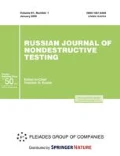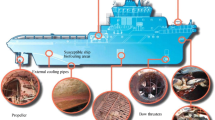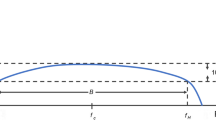Abstract
This research is a continuation of the work aimed at analyzing the parameters of ultrasonic signals during high-speed rail inspection. The analysis of the behavior of the amplitudes of the sequences of bottom signals in the zone most problematic for the continuous-welded track, i.e., the zone of the welded joints of rails, has been carried out in a wide range of inspection speeds. It is shown that, starting from certain scanning speeds, in accordance with the current regulatory and technical documentation, many zones of welded joints can be attributed to unscanned areas. The research results can be used to optimize the designs of scanning systems for high-speed diagnostic systems and to substantiate permissible rail-track scanning speeds.









Similar content being viewed by others
Notes
The crush is the result of the process of surface plastic deformation of the rail when interacting with the wheels of the rolling stock, which manifests itself in a gradual change in the shape and size of the rail. Intensive development of saddles in operation is facilitated by the presence of an initial unevenness in the welded joint formed during welding of rails with end curvature or the absence or violation of hardening heat treatment of welded joints.
The highly defective rails (HDR) in contrast to the defective rails (DR) do not pose a direct threat to the train traffic and do not require immediate removal from the track.
REFERENCES
Markov A.A. and Maximova, E.A., Analyzing ultrasonic signal parameters during high-speed rail inspection, Russ. J. Nondestr. Test., 2021, no. 3 (in press).
Shur, E.A., Fedin, V.M., Borts, A.I., Ronzhina, Yu.V., and Fimkin, A.I., Ways to eliminate increased damage to rails in the zone of welded joints, Vestn. VNIIZhT, 2019, vol. 78, no. 4, pp. 210–217.
Gudkov, A.V., Berzin, M.M., and Lozinsky, V.N., The main directions and results of the development of the welding department for 60 years, Svarochnie i naplavochnie tekhnologii na zheleznodorozhnom transporte (Welding and Surfacing Technologies in Railway Transport), Moscow: Intekst, 2008, pp. 3–29.
Saita, K., Karimine, K., Ueda, M., Iwano, K., Yamamoto, T., and Hiroguchi, K., Trends in rail welding technologies and our future approach, Nippon Steel Sumitomo Met. Tech. Rep., 2013, no. 105, pp. 84–92.
Stepanova, L.N., Kabanov, K.V., Kanifadin, K.V., Lebedev, E.Yu., and Bugrov, A.V., Research of the process of welding rails by the acoustic emission method, Kontrol’ Diagn., 2011, no. 12, pp. 12–15.
Kalashnikov, E.A. and Korolev, Yu.A., Rail welding technologies: Trends in Russia and abroad, Put’ Putevoe Khoz., 2015, no. 8, pp. 2–6.
Kossov, V.S., Krasnov, O.G., and Akashev, M.G., Influence of collapse in the zone of welded joints on the force effect of rolling stock on the track, Vestn. VNIIZhT, 2020, vol. 79, no. 1, pp. 9–16.
Gorkanova, T.N., At the meeting of the commission on rail facilities, Put’ Putevoe Khoz., 2020, no. 11, pp. 19–20.
Markov, A.A. and Kuznetsova, E.A., Defektoskopiya rel’sov. Formirovanie i analiz signalov. Kn. 2. Rasshifrovka defektogramm (Defectoscopy of Rails. Formation and Analysis of Signals. Book 2: Interpretation of Defectograms), St. Petersburg: Ul’tra Print, 2014.
Gurvich, A.K., Zerkal’no-tenevoi metod ul’trazvukovoi defektoskopii (Mirror-Shadow Method of Ultrasonic Flaw Detection), Moscow: Mashinostroenie, 1970.
Tarabrin, V.F., Comparison of characteristics of search systems of mobile means of rail defectoscopy, Kontrol’ Diagn., 2020, vol. 23, no. 10, pp. 40–48.
Knyazev, D.A., High-speed inspection of welded rail joints of a railway track by the echolocation method of ultrasonic inspection of rails, V Mezhdunarodnaya nauchn. Konf. “Nauka Rossii: tseli i zadachi” (V Int. Sci. Conf. “Science of Russia: Tasks and Objectives”) (Ekaterinburg, 2017), pp. 16–21.
Antipov, A.G. and Markov, A.A., Detectability of rail defects by magnetic flux leakage method, Russ. J. Nondestr. Test., 2019, vol. 55, no. 4, pp. 277–285.
Markov, A.A., Antipov, A.G., and Karelin, M.V., Assessment of the reliability of automatic recognition of signals from structural elements of the rail track by the MD method, Kontrol’ Diagn., 2018, no. 3, pp. 16–27.
Author information
Authors and Affiliations
Corresponding author
Rights and permissions
About this article
Cite this article
Markov, A.A., Maksimova, E.A. Analysis of the Parameters of Bottom Signals in the Area of Welded Joints of Rails under High-Speed Ultrasonic Testing. Russ J Nondestruct Test 57, 383–392 (2021). https://doi.org/10.1134/S1061830921050107
Received:
Revised:
Accepted:
Published:
Issue Date:
DOI: https://doi.org/10.1134/S1061830921050107




